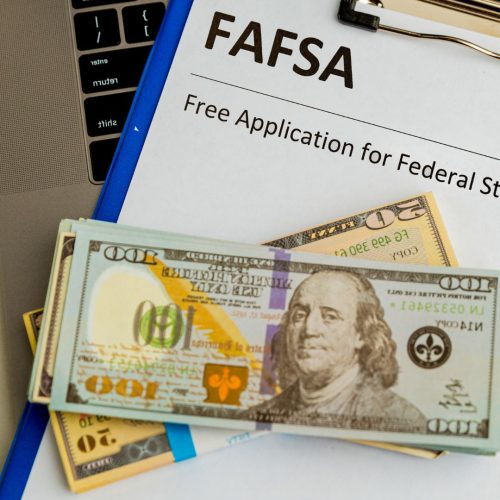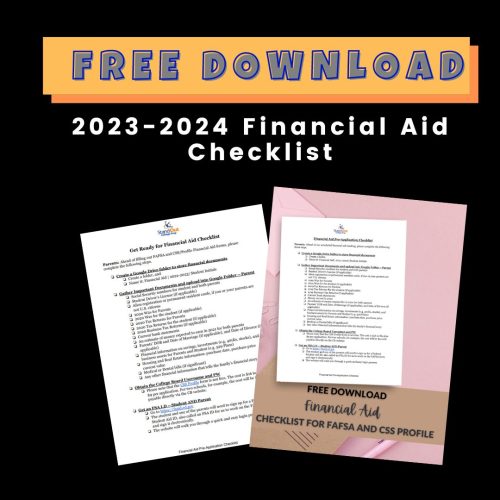If you’re a U.S. high school student looking dreaming of attending college, paying for college can be overwhelming. But there’s good news! By filling out the Free Application for Federal Student Aid (FAFSA), you can get financial help to cover your education costs. Now, you might be wondering, “What’s the deadline for the 2023-2024 school year?” Fear not! We’re here to provide you with all the critical information you need so that you don’t miss out on valuable financial aid opportunities.
Learn more about FAFSA:

Table of Contents

What is FAFSA and why is it important?
FAFSA, or the Free Application for Federal Student Aid, is a form that students in the United States complete to apply for financial aid to help pay for college or other post-secondary education. This aid comes from the federal government, state governments, colleges, and other organizations.
FAFSA is important for several reasons:
- Access to financial aid: By filling out the FAFSA, you become eligible for various types of financial assistance, such as grants, work-study programs, and low-interest federal student loans. These resources can significantly reduce the cost of your education.
- Determining your financial need: The FAFSA considers your family’s financial situation to determine how much financial aid you’re eligible to receive. This helps ensure that students with greater financial need receive more assistance.
- Opens doors for scholarships: Many colleges and scholarship programs use the information provided in the FAFSA to determine your eligibility for their scholarships or other forms of financial aid.
- Required by most colleges: Most colleges and universities in the United States require the FAFSA to be completed by students seeking financial aid. Without submitting the FAFSA, you may miss out on valuable financial assistance opportunities.
Filling out the FAFSA is important because it can help you pay for college and reduce the amount of student debt you may have to take on.

Key FAFSA Deadlines for the 2023-2024 Academic Year
The federal deadline for submitting the FAFSA for the 2023-2024 academic year is June 30, 2024. However, keep in mind that many states and colleges set their own deadlines, which might be earlier than the federal deadline. To increase your chances of receiving financial aid, it’s best to complete your FAFSA as soon as it becomes available on October 1, 2022.

What If You Miss the FAFSA Deadline or Start School Late?
If you’re an incoming student and miss the financial aid deadline, don’t worry—you have until the following June to apply for financial aid and, if eligible, receive it retroactively. Similarly, if you begin college during the spring semester, you can still apply for financial aid. This extended timeline offers some flexibility, but it’s essential not to procrastinate. Financial resources can be limited, and waiting too long might mean missing out on available aid.
Remember, the earlier you submit your FAFSA, the better your chances are of securing the financial assistance you need to make your college dreams a reality.

Tips for maximizing your financial aid eligibility
Maximizing your financial aid eligibility can help you receive more money for college and reduce your out-of-pocket expenses. Here are some tips to help you get the most out of your financial aid:
- Apply early: The earlier you submit your FAFSA, the better your chances of receiving more financial aid.
- Provide accurate information: Make sure all the information you provide on your FAFSA is accurate and up-to-date. Any errors or inconsistencies could delay your application or result in less financial aid.
- Consider all sources of aid: Don’t just rely on federal financial aid. Look into scholarships, grants, and other forms of aid that can help you pay for college.
- Keep your grades up: Many scholarships and grants require a certain GPA or academic achievement. Make sure you are meeting these requirements to qualify for more aid.
- Talk to your financial aid office: If you have any questions or concerns about your financial aid, don’t hesitate to reach out to your school’s financial aid office. They can provide guidance and assistance to help you maximize your aid eligibility.

How to Complete the FAFSA?
Step 1: Figure Out if You're a Dependent or Independent Student
Before you start filling out the FAFSA, it’s important to know if you’re a dependent or independent student. This will affect what information you need to provide on the form.
If you depend on your parents for financial support, you’re most likely a dependent student. In this case, you’ll need to include your parents’ financial information on the FAFSA.
If you meet certain requirements, like being 24 years old or older, married, a military veteran, or a graduate student, you might be an independent student. As an independent student, you won’t need to provide your parents’ financial information on the FAFSA
Remember, the earlier you submit your FAFSA, the better your chances are of securing the financial assistance you need to make your college dreams a reality.
Step 2: Make an FSA ID
Once you know your dependency status, the next step is to create an FSA ID. An FSA ID is a username and password that you’ll use to access and sign your FAFSA online. It’s also used to log in to certain U.S. Department of Education websites.
To make an FSA ID, follow these steps:
- Go to the FSA ID website: fsaid.ed.gov
- Click “Create Account” and follow the instructions to create your username and password.
- Provide your email address, Social Security number, date of birth, and other personal information.
- Choose security questions and answers you’ll remember easily.
- Review the information you provided and confirm your email address.
Keep your FSA ID safe, and don’t share it with anyone. You’ll need it each year when you fill out the FAFSA and when you want to check the status of your financial aid application. If you’re a dependent student, your parent(s) will also need to create their own FSA ID to sign your FAFSA.
Step 3: Gather the necessary documents
Before you start filling out the FAFSA, make sure you have all the necessary documents on hand. This will make the process smoother and help you avoid errors. Here’s a list of documents you might need:
- Your Social Security number (and your parents’ Social Security numbers if you’re a dependent student)
- Your driver’s license number (if you have one)
- Your Alien Registration number (if you’re not a U.S. citizen)
- Federal tax returns for you and your parents (if you’re a dependent student) or just for you (if you’re an independent student). This might include IRS W-2 forms or other records of income.
- Bank statements and records of investments (if applicable)
- Records of untaxed income, such as child support or veterans non-education benefits (if applicable)
Having these documents ready will make it easier for you to complete the FAFSA accurately and quickly. Make sure to use the correct tax year information, as the FAFSA usually requires financial data from two years before the academic year for which you’re applying.
If you don’t have a social security number, be sure to do a paper copy of the FAFSA application. If you're parents do not have a social security number (and you do), then put in 000-00-0000.
Step 4: Provide all requested information
Now that you have all the necessary documents, it’s time to complete the FAFSA. Go to the FAFSA website at fafsa.ed.gov and start your application. Make sure to answer all the questions, and use the information from the documents you gathered in Step 3. The FAFSA will ask about your personal information, your family’s financial situation, and the colleges you’re interested in attending. Be honest and accurate with your answers, as this will affect the amount of financial aid you can receive.
Step 5: Sign and submit your FAFSA
Once you’ve completed the FAFSA, it’s time to sign and submit it. If you’re an independent student, you’ll sign with your FSA ID. If you’re a dependent student, both you and one of your parents will need to sign using your respective FSA IDs.
Before submitting your FAFSA, double-check all the information to make sure it’s accurate. Correct any mistakes, as errors can delay the processing of your financial aid. After you’ve reviewed everything, submit your FAFSA.

What to do after you fill out the FAFSA?
Keep an eye on your email, as you might receive notifications about your application, such as updates on your application status or requests for additional information like tax transcripts or proof of citizenship. For example, you may be asked to provide further documentation to verify your income or to confirm your enrollment status at your chosen college. Respond promptly to any requests to ensure your financial aid is processed as quickly as possible, as delays in submitting the required information can affect your financial aid disbursement and potentially impact your ability to pay for college expenses on time.
Do you have to fill out the FAFSA?
Filling out the FAFSA is not mandatory, but it is highly recommended if you want to access financial aid for college or other post-secondary education. By submitting the FAFSA, you can become eligible for federal, state, and institutional financial aid, including grants, work-study programs, and low-interest loans.

Who should fill out the FAFSA
Students who plan to attend college or other post-secondary education programs in the United States and need financial assistance should fill out the FAFSA. This includes high school seniors, current college students, and nontraditional students, such as adult learners or students returning to college after a break. If this is you, then you’ll want to fill out the FAFSA.
Who doesn't need to fill out the FAFSA?
Students who don’t need financial assistance or are certain they won’t qualify for any form of aid might choose not to fill out the FAFSA. However, since the application is free and many factors influence eligibility, it’s generally a good idea to complete the FAFSA even if you think you won’t qualify for aid.

State and school deadlines
Each state and college may have its own FAFSA deadline, which can be earlier than the federal deadline. To avoid missing out on financial aid opportunities, check the deadlines for the state and schools you’re interested in attending. You can find state deadlines on the FAFSA website or by contacting your state’s financial aid agency. College deadlines can be found on the school’s financial aid website or by contacting their financial aid office.

What happens if you miss the FAFSA deadline?
Missing the FAFSA deadline can result in limited or no financial aid. Some forms of aid, such as grants and work-study programs, have limited funding and are awarded on a first-come, first-served basis. Missing the deadline might mean missing out on these opportunities. Additionally, you may not be eligible for federal loans or other types of aid. If you miss the deadline, contact your school’s financial aid office to discuss your options and determine if you can still apply for any financial assistance.

Tips for filling out the FAFSA
1. File early
The earlier you submit your FAFSA, the better. Some financial aid programs have limited funding, so applying early can increase your chances of receiving aid. Plus, you’ll have more time to address any issues or provide additional information if needed.
2. Make changes if your financial situation has changed
If your family’s financial situation has changed significantly since the tax year used on your FAFSA, contact your college’s financial aid office. They can help you update your information, which may lead to additional aid eligibility.
3. Apply even if you don't think you'll qualify for aid
Some students assume they won’t qualify for financial aid and don’t bother applying. However, many factors are considered in determining aid eligibility, and you might be surprised by the assistance you can receive. Remember, the FAFSA is free to submit, so there’s no harm in applying.
4. Sign up for Financial Aid Session
Many high schools and colleges offer financial aid workshops or sessions to help students and parents navigate the FAFSA process. Attend one of these events to get expert advice, ask questions, and better understand the financial aid process.

Frequently Asked Questions about FAFSA Deadline
When is the federal FAFSA deadline?
The federal FAFSA deadline is typically June 30 of the academic year for which you’re applying for aid. For example, for the 2023-2024 academic year, the deadline is June 30, 2024.
Do states and schools have their own FAFSA deadlines?
Yes, states and schools often have their own FAFSA deadlines, which may be earlier than the federal deadline. It’s essential to check with your state’s financial aid agency and your chosen school’s financial aid office to ensure you meet all relevant deadlines.
Can I submit the FAFSA after the deadline?
While you can technically submit the FAFSA after the federal deadline, doing so may limit your eligibility for certain types of financial aid. Submitting the FAFSA by the appropriate deadlines ensures the best chance of receiving aid.
Can I make changes to my FAFSA after submitting it?
Yes, you can make changes to your FAFSA after submitting it. If you need to update or correct any information, log in to your FAFSA account using your FSA ID and make the necessary changes. Keep in mind that changes may impact your eligibility for financial aid, so be sure to update your FAFSA as accurately as possible.
When should I start working on my FAFSA?
You should start working on your FAFSA as soon as possible after October 1 of the year before the academic year for which you’re applying for aid. This will give you enough time to gather all the necessary documents, complete the application accurately, and submit it before any federal, state, or school deadlines.
How do I find out if I've received financial aid?
After you’ve submitted your FAFSA, you’ll receive a Student Aid Report (SAR) summarizing the information you provided. Your chosen colleges will also receive this information and will use it to create a financial aid package for you. You’ll receive a financial aid award letter from each college that details the types and amounts of aid you’re eligible for. Be sure to review these letters carefully and compare the aid packages before making your final decision.
Conclusion + Next Steps
Now you know that completing the FAFSA is an essential step for students seeking financial aid to help pay for college or other post-secondary education programs. Paying attention to FAFSA deadlines is crucial to maximizing your chances of receiving financial aid. By understanding the process and following the tips mentioned in this post, you can navigate the FAFSA deadlines more efficiently and make the process smoother.
Remember to stay organized, gather all the necessary documents, and submit your FAFSA as early as possible to avoid missing out on valuable financial assistance. With careful planning and attention to detail, you can successfully secure the financial aid you need to achieve your educational goals.







